Celery
Celery (Apium graveolens) is originally a marshland plant. Although the plant is by nature a hardy biennial, it is grown as an annual. It is classed as a cool-weather crop which, in the US for example, means that it is a winter crop in southern areas, a summer crop in the far north, and ideal in the fall elsewhere.
This versatile plant has been domesticated and cultivated as an edible crop in many countries for thousands of years. In addition to eating the leaves and stalks, the seeds found a place in both spices and traditional, herbal medicine. Today celery is experiencing increased popularity.
The History Of Celery
Although it is unclear if it was wild or cultivated celery, leaves and flowers from the plant were in the garlands found in Tutankhamun’s tomb. This Ancient Egyptian pharaoh died in 1,323 BC. Celery seed pods dated to the 7th century BC were discovered in Greece and the plant is celebrated in the works of the poet and author, Homer.
Surprisingly, celery only arrived in England from Europe and the Mediterranean in the middle of the 17th century where it was used as a much-prized addition to a range of hot and cold dishes. By the end of the century, careful and selective propagation succeeded in reducing the bitterness and increasing the sweetness.
The first written record of celery in the US is from 1806 and lists it as a species of parsley. It was only in the mid-19th century that the plant achieved widespread – and enormous – popularity in North America.
Where This Plant Is Found
Celery is believed to have originated in the Middle East and the Mediterranean region. It is most suited to marshland environments. For many centuries wild celery was foraged and harvested. It took some time before widely accepted edible varieties that could be grown commercially and domestically were produced.
This plant is now common (and popular) throughout western Europe, the British Isles, North America, the Mediterranean, Australia, Southern Africa, Asia Minor, the Caucasus, and South America.
How To Identify Celery
Apium graveolens is, as mentioned, a biennial when it grew naturally or in the wild. These plants therefore only produce flowers and seeds in their second year. A mature plant can reach a height of 3.3 feet / 1 meter. Celery produces a rosette of stalks that are topped with leaves.
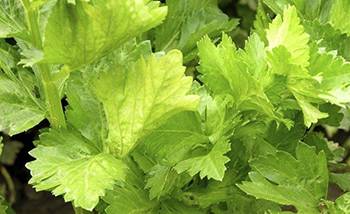
When grown commercially for the table it is the stalks and leaves that are prized. As a result, certain cultivars have been developed that produce particularly robust stalks or stems. The seeds are used for propagation, remedies, and some recipes.
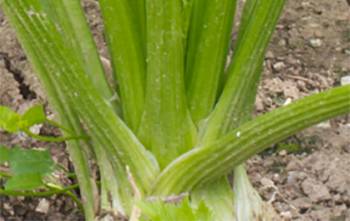
- Leaf: The leaves are light green, pinnate, or bipinnate (feathery) and each leaflet is rhombic (diamond-shaped) and serrated.
The tip of each serration looks white. The leaves can reach 2 ½ inches / 6 ¼ centimeters in length and 1 ½ inches / 4 centimeters in width.
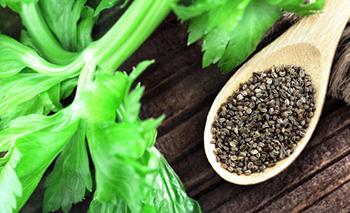
- Stalk: The stalks and green, fleshy, and fibrous or stringy. They taper upwards and terminate in the leaves.
Each stalk curls inwards slightly creating one convex and one concave side. The convex / outer side is grooved.
- Seeds: The tiny seeds are oval and broad.
They are grooved and light brown or green in color.
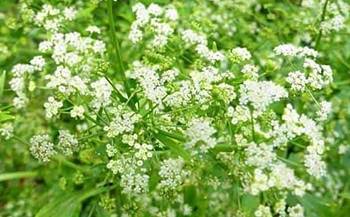
- Flower: The small, creamy-white flowers form in dense clusters at the end of stalks.
Once they die, they go to seed and form the pods that contain the seeds.
Each of these can assist in identifying celery plants. However, there are some other plants that can cause confusion. These are described in a later section.
How To Grow Celery
Confusingly, some people say that celery is challenging to grow while others say it’s easy. The only way to find out is to try! These plants have certain environmental requirements:
- Temperatures should be on average 500 Fahrenheit / 100 Celsius at night and the daytime average between 60 and 700 Fahrenheit / 15.5 and 210 To complicate matters, temperatures must be consistent for 5 or 6 months.
- Soil that retains moisture, is nutrient-rich, and has a pH of 6 – 7
- Good sunlight but some shade or protection at the hottest time of day.
Celery also requires frequent watering. If the soil dries out the plant’s taste will be affected and, in the worst-case scenario, the plant will die.
When it comes to growing your own celery plants, you have several options. You can propagate from seeds, grow from a stalk base, or – the easiest option – buy young plants from a reputable dealer.
Propagating From Seed & Planting Out
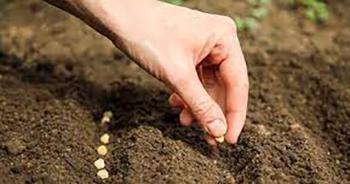 To reduce the time until harvest, seeds can be started indoors 10 – 12 weeks before the anticipated final frost. Soaking the seeds overnight will speed up germination. Use seed trays or suitable pots filled with moist compost and place them in an area where the temperature will be a steady 590 Fahrenheit / 150 Celsius.
To reduce the time until harvest, seeds can be started indoors 10 – 12 weeks before the anticipated final frost. Soaking the seeds overnight will speed up germination. Use seed trays or suitable pots filled with moist compost and place them in an area where the temperature will be a steady 590 Fahrenheit / 150 Celsius.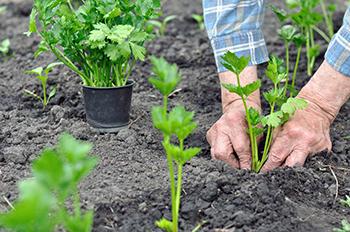
Because celery seeds are extremely small and hard to handle, it can make it easier to mix them into some fine sand which is then be sprinkled over the top of the prepared compost. You can then add a further very thin layer of moist soil over that.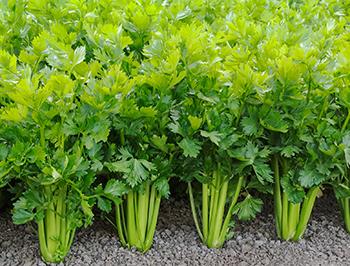
Once the seedlings reach 2 inches / 5 centimeters in height they can be planted out into larger containers. They should be transplanted into fresh, nutrient-rich, moist soil. Seedlings should be 2 inches / 5 centimeters apart to allow for growth.
When they have doubled in height – and if weather conditions are suitable – they can then be planted outdoors 8 inches / 20 centimeters apart. The water around each plant with a liquid fertilizer after planting and continue to do so every week. Celery plants require frequent watering throughout their growing season.
Be patient as this plant takes 130 – 140 days to mature!
Growing Celery From A Stalk Base
First, select a bunch of celery that is fresh, has tightly packed stalks, and green leaves. You can either use a container with water or one with potting soil in it. Then: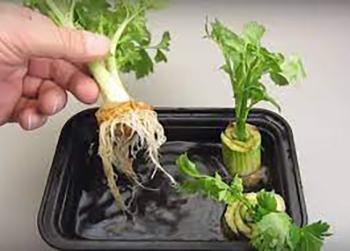
- Cut off the bottom of the celery bunch about 2 inches / 5 centimeters from the base
- Place the base into a small container that either has some moist potting soil in the bottom OR has 1 inch / 2 ½ centimeters of water in it
- Place the container in a bright area and top up the water OR keep the soil moist by watering regularly
- The base should sprout after a few days.
If you want to produce tasty leaves rather than long, fleshy stalks, this may be an option.
Common Pests And Problems
As with most other plants, celery is prone to attack from certain pests and plants diseases:
- Slugs and snails: these will eat leaves and may also damage stalks
- Leaf spot: begins as brown spots on older leaves before affecting new growth too.
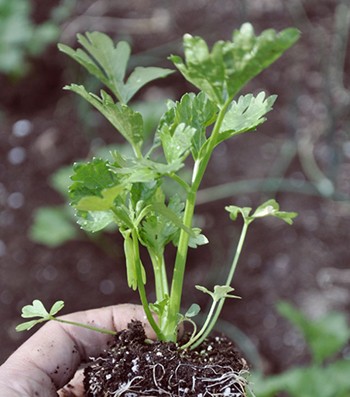
In addition, there are environmental issues that can cause yellowing, rot, stunted growth, or death. For example:
- Yellowing leaves are often a sign of nitrogen deficiency. Although the leaves show symptoms, this issue will stunt the growth of the whole plant.
- While celery requires moisture, too much water will cause the roots to rot, and the plant will die.
- Blackening of the center of the plant may indicate calcium and/or magnesium deficiency.
You can grow celery in a container if you don’t have a garden. You will require a pot that has a diameter of 8 inches / 20 centimeters so that the plant has enough space. The container must also be placed somewhere that will meet the various environmental requirements and don’t forget to watering and feeding.
How To Harvest And Store This Plant
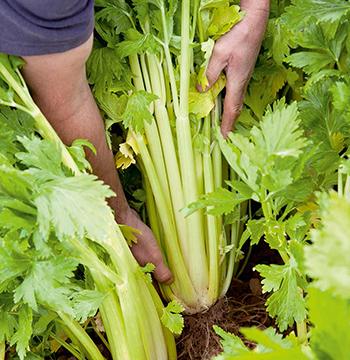 Celery is one of the cut-and-come-again plants. In other words, if you only remove some outer stalks, the plant will continue to grow and thrive. This provides you with an ongoing supply of fresh stems and leaves.
Celery is one of the cut-and-come-again plants. In other words, if you only remove some outer stalks, the plant will continue to grow and thrive. This provides you with an ongoing supply of fresh stems and leaves.
If, however, you want to store celery longer term, you can hang the stalks upside down in a warm but well-ventilated area to dry out. They can then be stored whole or crumbled.
This is a biennial plant, so while you can harvest leaves and stalks as soon as they are ready, seeds can only be harvested in the second year. Wait until the seed casings/pods are hard and the seeds themselves are ready: they will be dark brown and hard. Place the flower head into a bag and shake it carefully to loosen the seeds which then fall into the bag.
If seeds are thoroughly dried, and stored in an airtight container and, preferably in a cool, dark place, they can be kept for up to 5 years.
… Of course, you could just buy celery – both fresh and seeds – from your local store!
What Celery Is Good For & The Natural Remedies Made From It
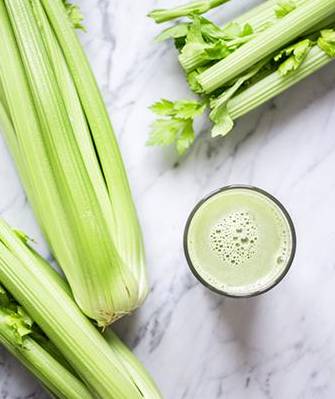
Celery owes much of its reputation as a health-boosting food to the range of vitamins and minerals it contains:
- Calcium
- Choline
- Copper
- Iron
- Magnesium
- Phosphorus
- Potassium
- Sodium
- Vitamins A, B-1, B-2, B-3, B-5, B-6, B-9, B-12, C, D, E, and K
In addition to these, the plant is rich in fiber, contains a lot of water, and is low in carbohydrates. This makes it an excellent option for those trying to lose weight and safe for diabetics. The various other benefits celery is believed to offer include that it: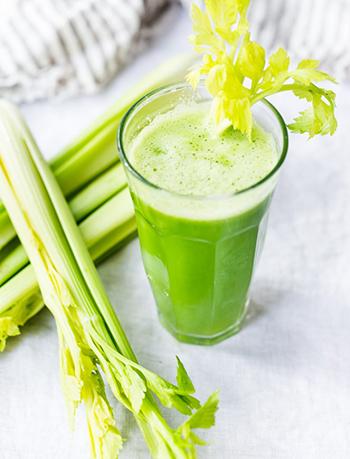
- Has a calming effect thanks to its essential oils
- Aids digestion
- Lowers blood pressure
- Has diuretic properties
- Improves hair and skin health
- Is an antioxidant and might therefore protect against some forms of cancer
- Eases mild to moderate pain
- Reduces inflammation
- Lowers cholesterol
- Acts as a tonic for the liver
- Eases muscle spasms.
It should be noted, however, that while there is extensive anecdotal evidence going back many centuries for many of the above, there is a lack of clinical evidence to date for any of them.
What Parts Of The Plant Are Used In Remedies?
The stalks, leaves, and seeds are all utilized when preparing remedies. These include juice, decoctions made with seeds, essential oil, and tablets or capsules made from the seeds.
A DIY Celery Recipe
While you could buy ready-made celery juice, fresh is always best! In addition, it’s not a time-consuming or difficult thing to do if you follow this DIY recipe.
Ingredients
- 9 – 12 stalks of fresh (preferably organic) celery
- ¼ cup of filtered or purified water.
Method
- Cut the base off the bunch and separate the stalks
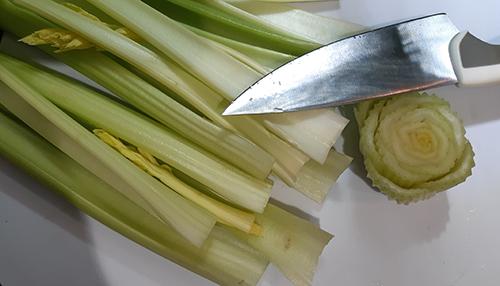
- Wash the celery stalks thoroughly, especially non-organic celery
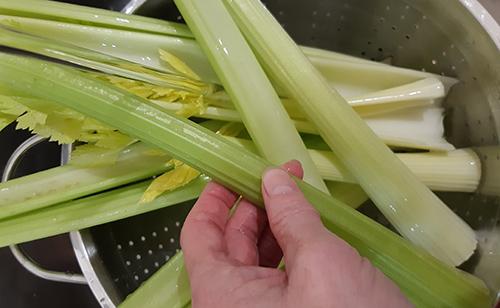
If you use a juicer:
- Feed the stalks through the juicer
- Drink immediately.
If you use a blender:
- Cut the washed stalks into 1 inch / 2 ½ centimeter long pieces
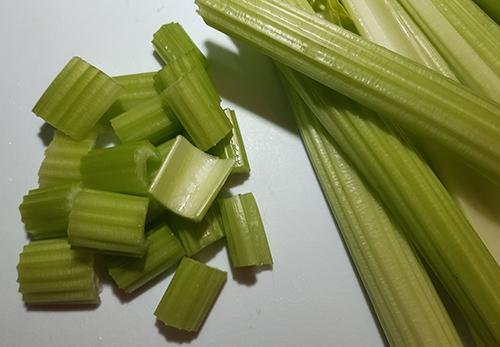
- Place them in the blender, add the water and place the lid on the blender
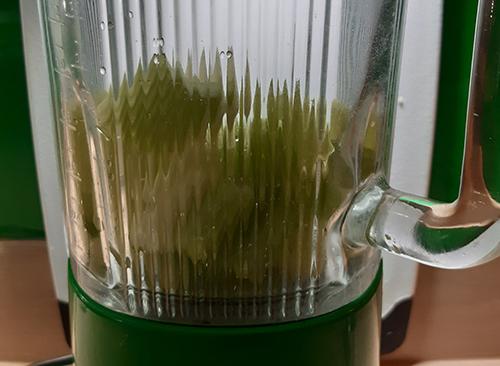
- Blend until smooth
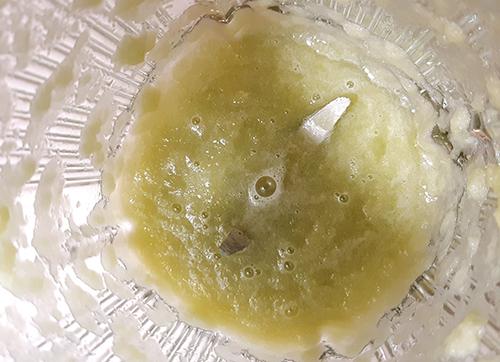
- Use cheesecloth or kitchen muslin to strain the juice to remove the fibers
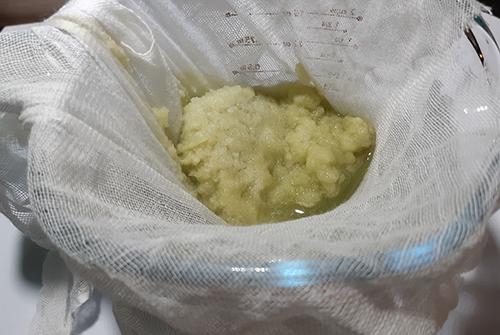
- Squeeze the cloth to extract as much liquid as possible.
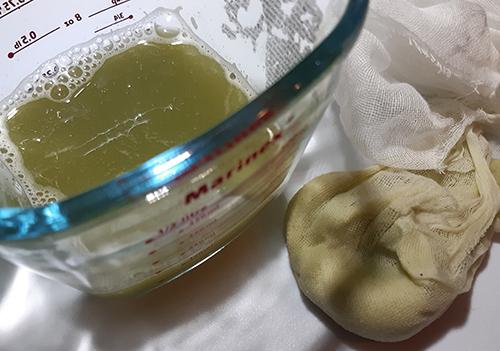
This juice should be drunk each morning, preferably on an empty stomach. If you can wait 30 minutes before you eat or drink anything else.
Dosage
How much celery you take or use daily depends on the form it takes. Because of the lack of clinical data, dosages are not entirely clear. However, suggested quantities are:
- The above juice recipe should produce approximately 16 ounces / 2 cups / 450 milliliters which is the suggested daily intake of celery juice.
- A decoction of ½ teaspoon seeds in ½ cup of water daily
- 6 – 8 drops of oil mixed in water twice a day.
As a rule, though, you should follow the instructions of your healthcare provider or the directions on the packaging of any store-bought products.
Remember that health products should only be purchased from reputable retailers.
What Plants Resemble Celery?
There is, unsurprisingly, confusion between two varieties of celery – Apium graveolens and Apium graveolens secalinum – and Levisticum officinale, which is commonly known as Lovage. The primary reason for this is that the leaves and stalks are similar. Fortunately, there are differences you can spot once you know about them:
While you might not get quite the flavor you hoped for if you confuse these plants, at least all three of them are edible!
Warning And Cautions
As with other plants, some individuals may be allergic to celery in both its raw and cooked form and particularly to the seeds. In addition, these reactions can be of a serious nature. Celery in fact belongs to a small group of highly allergenic foods which includes peanuts.
This plant should also be avoided or ingested only in great moderation by individuals who have impaired kidney function and patients on blood pressure medication.
The oil should not be used on the skin if you are going to be exposed to bright sunlight as it can increase light sensitivity. Pregnant and breastfeeding women should not ingest celery oil or seeds as they may lead to uterine contractions.
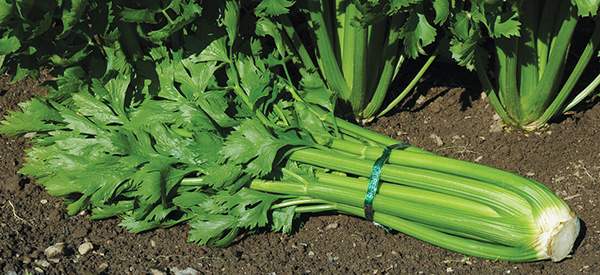
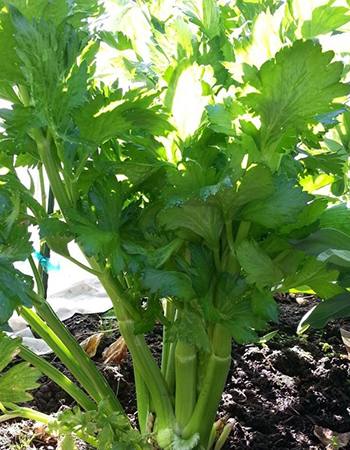
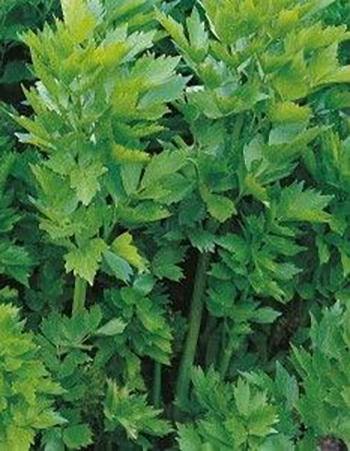
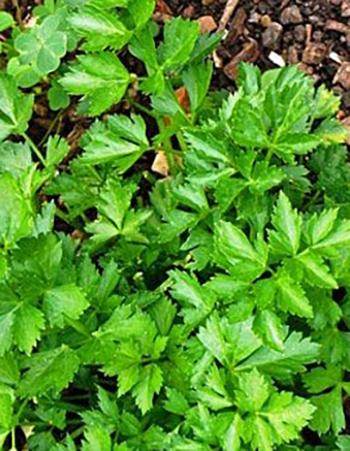
Comments
Post a Comment